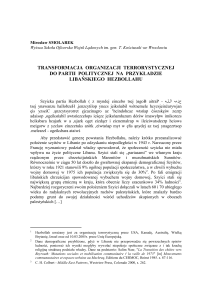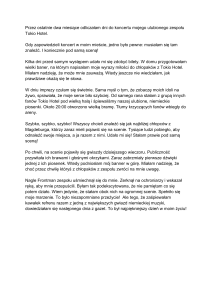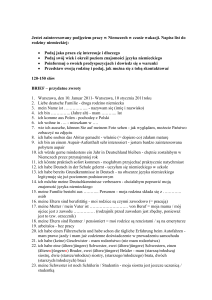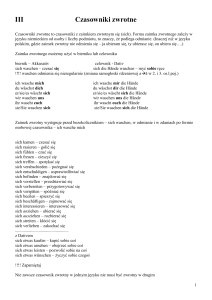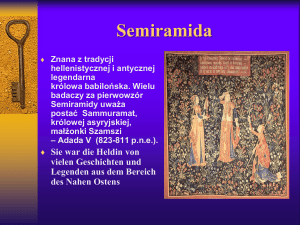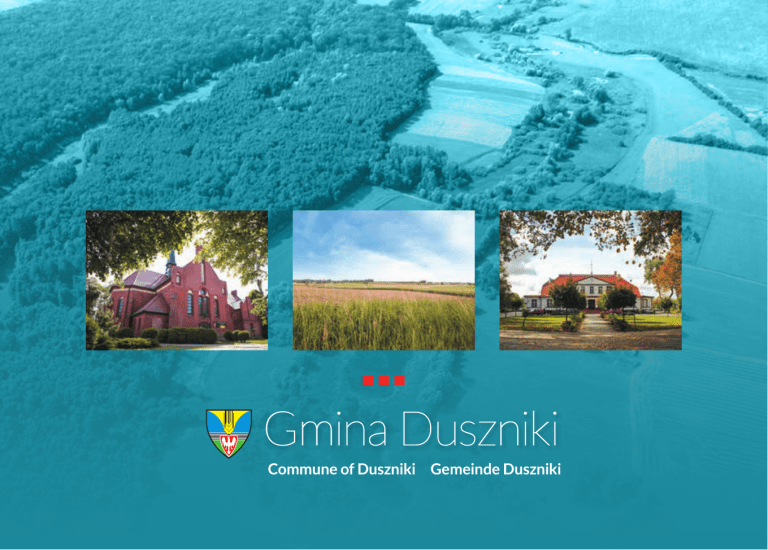
Gmina Duszniki
Commune of Duszniki Gemeinde Duszniki
O gminie
Gmina Duszniki położona jest w centrum
województwa wielkopolskiego, w odległości ok. 40 km od Poznania. Zajmuje obszar
15 628 ha, w 20 miejscowościach (17 sołectw)
zamieszkuje 8 500 mieszkańców.
Ziemia dusznicka leży w dorzeczu dwóch
ramion rzeki Mogilnicy, na falistej równinie
urozmaiconej wzniesieniami polodowcowymi.
Pozostałością po lodowcu są także niewielkie
jeziora: Wilczyńskie (8,5 ha) i Niewierskie
(3,5 ha). W dawnych czasach była to kraina
porosła lasami, obfitująca w dzikie zwierzęta.
Za czasów pierwszych Piastów znajdowało
się tu kilka grodów stanowiących przedpole
obronne Poznania. Obecnie gmina ma typowo
rolniczy charakter. Użytki rolne zajmują prawie
About the commune
Allgemeines über die Gemeinde
The commune of Duszniki is situated in the
center of The Great Poland (pol. Wielkopolska) voivodship, 40 km from Poznan. It takes
up the area of 15 628 ha, has 20 villages (17
local units of administration) and 8.500 of
inhabitants.
Die Gemeinde Duszniki ist im Zentrum
der Wielkopolskie Woiwodschaft, in der
Entfernung von ca. 40 Kilometer von Poznań
situiert. Sie belegt die Fläche von 15628 Ha, in
20 Ortschaften (17 Schulzenämter) wohnen
8 500 Menschen.
The land of Duszniki is located at the basis
of two Mogilnica rivers’ forks, on the rolling
plain, varied by the postglacial hills. Small lakes:
Wilczynskie (8.5 ha) and Niewierskie (3.5 ha)
are also the remains of the glacier. A long time
ago it was a land of forests abounding in wild
animals. In the time of the first Piasts there
were some castles which fortified outskirts
of Poznan. At present the commune has
a typically agricultural character. Farmlands
Das Land von Duszniki liegt in dem
Flussgebiet der zwei Arme des Flusses
Mogilnica, auf der welligen Ebene, welche durch
die postglazialen Erhöhungen vervielfältigt
ist. Der Gletscher hinterließ auch kleine
Seen: Wilczyńskie (8,5 Ha) und Niewierskie
(3,5 Ha). In den früheren Zeiten war das ein
Land das mit Wälder bewachsen war, das voll
von Wild gewesen ist. In der Zeit der ersten
Herrscher der Piast - Dynastie befanden sich
hier einige Burgen, die das Schutzvorfeld
1
85%, lasy jedynie 6% powierzchni gminy. Istnieje tu ok. 800 indywidualnych gospodarstw rolnych. Przeważa produkcja trzody chlewnej
i produkcja zbóż, czemu sprzyjają korzystne warunki przyrodnicze,
w tym wysoki – ponad 70% udział gleb III i IV klasy. Na terenie gminy
nie ma wielkiego przemysłu, są za to liczne zakłady rzemieślnicze,
dobrze rozwinięta sieć handlowa, hurtownie z materiałami i środkami
do produkcji roślinnej, firmy budowlane i transportowe.
take up nearly 85%, forests only 6% of the commune area. There are
about 800 individual farms. Pig farming and cereal production dominates here and natural favorable conditions support them including
a high percentage of III and IV class of soil – above 70%. There is no big
industry but there are a lot of craftsman workshops, well developed
commercial network, building and shipping companies.
für Poznań darstellten. Heute hat die Gemeinde einen typisch
landwirtschaftlichen Charakter. Die landwirtschaftlichen Nutzländer
belegen fast 85%, die Wälder nur 6% der Gemeindefläche. Hier gibt
es ca. 800 individuelle, landwirtschaftliche Bauernhöfe. Überwiegt
die Züchtung des Borstenviehs und Produktion von Getreide, was
durch die Naturbedingungen begünstigt wird, darunter hoher – 70%
Anteil der Böden der III und IV Klasse. Im Gebiet der Gemeinde gibt
es keine große Industrie, dafür gibt es zahlreiche Handwerkbetriebe,
gut entwickeltes Handelsnetz, Großhandlungen mit Materialien und
Mitteln für die Pflanzenproduktion, Transport- und Baufirmen.
2
3
Przedszkole
w Dusznikach
Kindergarten in Duszniki
Kindergarten in Duszniki
Szkoła w Dusznikach
School in Duszniki
Schule in Duszniki
Oświata
Education
Bildung
Szkoła w Dusznikach
School in Duszniki
Schule in Duszniki
W gminie Duszniki edukacja dzieci i młodzieży odbywa się w trzech placówkach
oświatowych: w Dusznikach, Grzebienisku
i Sędzinku oraz w przedszkolu w Dusznikach
z oddziałami zamiejscowymi w Podrzewiu
i Sękowie oraz oddziałach przedszkolnych
przy szkołach podstawowych w Sędzinku
i Grzebienisku. Infrastruktura oświatowa
jest stale rozbudowywana i remontowana,
natomiast programy nauczania są wzbogacane dodatkowymi zajęciami w ramach różnych projektów. Zarówno gmina, jak i szkoła
w Grzebienisku prowadzą stałą współpracę
kulturalno-oświatową z partnerskimi gminami i szkołami w Illuce w Estonii, Taivalkoski
w Finlandii i Faβberg w Niemczech.
4
In Duszniki commune children and young
people learn in three educational institutions:
in Duszniki, Grzebienisko and Sędzinko and
in kindergartens in Duszniki, Sędzinko and
Grzebienisko. Educational infrastructure is
constantly being expanded and renovated,
while the educational programs are enriched
with additional activities within the framework
of various projects. Both the commune and
the school in Grzebienisko conduct regular
cultural and educational cooperation with
the commune and school in Illuka (Estonia),
Taivalkoski (Finland) and Faβberg (Germany).
In der Gemeinde Duszniki findet die
Ausbildung der Kinder und Jugend in der
Bildungsinstitutionen statt: in Duszniki,
Grzebienisko und Sędzinko sowie dem
Kindergarten in Duszniki mit den auswärtigen
Abteilungen in Podrzewie und Sękowo
und in den Kindergartenabteilungen
an den Grundschulen in Sędzinko und
Grzebienisko. Die Bildungsinfrastruktur
wird laufend ausgebaut und renoviert,
wiederum die Lehrprogramme werden um
zusätzliche Unterrichtstunden in Rahmen
der verschiedener Projekte bereichert.
Sowohl die Gemeinde als auch die Schule
in Grzebienisko führen eine dauerhafte
Kultur – Bildungszusammenarbeit mit der
Partnergemeinde und der Schule in Illulka in
Estland, Taivalkoski in Finnland und Faβberg
in Deutschland.
Szkoła w Grzebienisku
School in Grzebienisko
Schule in Grzebienisko
5
Kultura
6
Od wielu lat społeczeństwo gminy Duszniki
wyróżnia się bardzo aktywną działalnością
kulturalną. Najbardziej reprezentatywnym
nurtem aktywności kulturalnej jest działalność muzyczna. Chór mieszany „Halka” przy
Gminnej Spółdzielni „Samopomoc Chłopska”
powstał w 1947 r. W latach osiemdziesiątych
powstały działające do dziś zespoły ludowe:
„Duszniczanka”, „Niewierzanka”, „Podrzewianka”, „Radość” z Chełminka, a w 1999 r.
„Pierwiosnek” z Sękowa. Zespoły te odnoszą
sukcesy na arenie krajowej, startując w różnego rodzaju konkursach czy przeglądach.
W Dusznikach działa Towarzystwo Miłośników
Ziemi Dusznickiej, które stworzyło muzeum
– Izbę Regionalną, gromadzącą historyczne
pamiątki i eksponaty. W Grzebienisku działa Bractwo Kurkowe – organizacja mająca
wielowiekową tradycję. W Grzebienisku również znajduje się lokalne muzeum, w którym
zgromadzono unikatowe eksponaty kultury
materialnej i ogólnej środowiska. Bractwo
Kurkowe prowadzi współpracę z bractwem
z partnerskiej gminy Faßberg w Niemczech.
Za planowanie i organizację imprez kulturalnych, spektakli, wystaw, koncertów, warsztatów, itp. odpowiada Biblioteka Publiczna
i Centrum Animacji Kultury w Dusznikach.
Zespół „Duszniczanka”
Culture
Kultur
For many years the society of Duszniki commune has distinguished itself by
a very active cultural activity. The most
representative trend of cultural activity is
the musical activity. The mixed choir “Halka” belonging to the Agricultural Cooperative “Peasant Self-Help” was established
in 1947. The folk bands: “Duszniczanka”,
“Niewierzanka”, “Podrzewianka”, “Radość”
from Chełminko, have been established in
the 1980s and “Pierwiosnek” from Sękowo
in 1999. They are successful on the national
scene starting in the various competitions
or reviews. The Society of Duszniki Region
Friends works in Duszniki. The Society created
the museum – The Regional Chamber which
collects historical memorabilia and exhibits. In
addition, Grzebienisko has the active Archers’
Fraternity with its centuries-old tradition.
Also in Grzebienisko there is a local museum
where the unique exhibits of material culture
and general environment has been collected.
Archers’ Fraternity cooperates with the
Fraternity from partnership commune from
Faßberg in Germany. The Public Library and
Cultural Animation Center is responsible for
the planning and organization of cultural
events, performances, exhibitions, concerts,
workshops, etc.
Seit vielen Jahren zeichnet sich die Gemeinschaft
der Gemeinde Duszniki mit einer sehr aktiven
Kulturtätigkeit aus. Die am meisten repräsentative
Strömung des kulturellen Schaffens ist die
musikalische Tätigkeit. Der gemischte Chor „Halka“
an der Gemeindegenossenschaft „Samopomoc
Chłopska“ wurde 1947 gegründet. In den 80-er
Jahren entstanden und sind weiterhin tätig die
Volksensembles: „Duszniczanka“, „Niewierzanka“,
„Podrzewianka“, „Radość“ aus Chełminko, und in
1999 „Pierwiosnek“ aus Sękowo. Die Ensembles
feiern Erfolge in Polen indem sie an verschiedener
Art Wettbewerben oder Rundschauen teilnehmen.
In Duszniki agiert auch die Gemeinschaft der
Liebhaber des Landes von Duszniki, die das
Museum – eine regionale Kammer errichtet hat,
welche eine Großzahl historischer Andenken
und Exponate enthält. In Grzebienisko ist auch
die Schützengilde tätig – eine Organisation, die
eine mehrere Jahrhunderte alte Tradition hat. In
Grzebienisko befindet sich auch das lokale Museum,
in dem einmalige Ausstellungsstücke der materiellen
und allgemeinen Kultur der Umwelt gesammelt
sind. Die Schützengilde arbeitet mit der Gilde aus
der Partnergemeinde Faßberg in Deutschland
zusammen. Für die Planung und Organisation
der Kulturveranstaltungen, Vorführungen,
Ausstellungen, Konzerte, Werkstätte usw. ist
die Öffentliche Bibliothek und das Zentrum der
Kulturanimation in Duszniki verantwortlich.
“Duszniczanka” Folk Group
Die Gruppe „Duszniczanka”
Koncert Chóru „Halka”
“Halka” Choir concert
Konzert des „Halka” Chors
I Dusznicki Festiwal
„Chcemy Country”
First Duszniki Country
Festival
I Festival von Duszniki
„Wir wollen Country”
Zabytkowy dworek
Duszniki - siedziba
instytucji kultury
Duszniki old manor house
– the seat of cultural
institution
Historisches Gutshaus
Duszniki – Sitz der
Kulturinstitution
Dożynki w Dusznikach
Harvest Festival
in Duszniki
Erntefest in Duszniki
7
Sport
Kompleks sportowy
w Dusznikach
Sport complex in Duszniki
Sportkomplex in Duszniki
Siatkówka plażowa
8
Beach volleyball
Strandvolleyball
W ostatnich latach intensywnej rozbudowie
uległa infrastruktura sportowa. W Dusznikach,
w sąsiedztwie szkoły podstawowej, powstał
kompleks sportowy z nowoczesną salą sportową, dwoma boiskami ORLIK, boiskiem do
siatkówki plażowej, placem zabaw i siłownią
zewnętrzną. Działalność w zakresie sportu,
poza strukturami administracji samorządowej, prowadzą kluby sportowe piłki nożnej
oraz uczniowskie kluby sportowe. Młodzież
z Dusznik ma w swym dorobku tytuły mistrzów
Polski i Wielkopolski, przede wszystkim
w lekkiej atletyce. Właśnie z uczniowskiego
klubu sportowego w Dusznikach wyszli reprezentanci Polski: Jarosław Araszkiewicz
(piłka nożna), Adam Skórnicki (żużel), Michał
Bartoszak (biegi) – nasz reprezentant na
olimpiadzie w Atenach, czy Piotr Lisek, który
w skoku o tyczce zdobywa miejsca na podium
Mistrzostw Europy i Świata.
In recent years sports infrastructure has
been intensively developed. A sports complex
with a modern sports’ hall, two ORLIK pitches,
a beach volleyball court, a playground and
an outdoor gym were created in the neighbourhood of the school in Duszniki. Besides
the local administration sports’ activities are
run by football clubs and sports’ clubs. The
youth of Duszniki has its achievements in
the Polish and Great Poland Championships,
particularly in athletics. The Polish representatives such as: Jarosław Araszkiewicz
(football), Adam Skórnicki (speedway racing)
and Michał Bartoszak (runs) who was the
Polish representative at the Olympic Games
in Athens, Piotr Lisek who wins the European
and world championship podium derived from
the sport club in Duszniki.
In den letzten Jahren einem intensiven
Ausbau wurde die Sportinfrastruktur unterzogen. In Duszniki in der Nachbarschaft der
Grundschule und des Gymnasiums entstand
ein Sportkomplex mit moderner Sporthalle,
zwei Spielfeldern ORLIK, Strandvolleyballplatz, Spielplatz und Freiluftfitnessanlage.
Die Aktivität im Bereich des Sports, außer
der Strukturen der Selbstverwaltung, führen
die Fußballklubs sowie Schülersportklubs aus.
Die Jugend aus Duszniki hat viele Errungenschaften unter anderen die Landesmeistertitel
und Meistertitel der Wielkopolska –Region,
vor allem in Leichtathletik. Eben aus dem
Schülersportklub stammen die Nationalwettkämpfer: Jarosław Araszkiewicz (Fußball),
Adam Skórnicki (Speedway) oder Michał
Bartoszak (Laufsport) – unser Repräsentant
bei den Olympischen Spielen in Athen.
9
Duszniki
10
Stacja kolejowa
w Dusznikach
– zdjęcie historyczne
Duszniki to duża i piękna wieś, będąca
siedzibą Urzędu Gminy, położona ok. 40 km
na zachód od Poznania. Istnieją dwie teorie
wyjaśniające pochodzenie nazwy Duszniki.
Pierwsza mówi, że w przeszłości na tym
terenie były mokradła, powodujące „duszne
powietrze”. Według drugiej natomiast wieś
była niegdyś posiadłością książąt piastowskich,
przekazaną biskupom poznańskim w zamian
za obowiązek odprawiania mszy świętej za
dusze ofiarodawców.
Duszniki is a big and beautiful village with
the headquarter of the Commune Hall in
its area. The village is about 40 km west of
Poznan. There are two theories explaining the
background of the name Duszniki. The first
one says that in the past there were marshes
causing “sultry weather”. According to the
second one the village was formerly the estate
of dukes of Piast handed down to bishops of
Poznan in return of the obligation to celebrate
masses for deceased benefactors’ intension.
Dzieje Dusznik są mocno powiązane z historią Wielkopolski. Wykopaliska archeologiczne
dowiodły, że okolica ta była zamieszkana
od dawna. Od roku 1303 Duszniki należały
do dóbr biskupstwa poznańskiego. Kościół
powstał tu prawdopodobnie w XII wieku,
ponieważ w tym czasie właśnie zaczęto nadawać kościołom tytuł św. Marcina. Pierwsza
wyraźna wzmianka o Dusznikach pochodzi
z 1417 roku - parafia wspomniana jest z okazji
wizytacji biskupiej. W okresie zaborów Duszniki znalazły się pod pruskim panowaniem.
Z historycznych zapisków dowiadujemy się,
że w 1808 r. wybudowano tu szkołę ludową,
w 1812 r. uruchomiono mleczarnię, w 1876
roku powstało Towarzystwo Gimnastyczne
„Sokół”, a w 1888 r. założono kółko rolnicze.
W 1905 r. powstała kolejka wąskotorowa, która
połączyła Duszniki z cukrownią w Opalenicy.
The history of Duszniki is tightly connected
with the history of The Great Poland. The
archeological excavations proved that the
surrounding had been inhabited for a long time.
Since 1303 Duszniki belonged to the estate
of Bishopric of Poznan. The church was built
probably in the 12th century because at that
time exactly churches were starting to be given
the name of Saint Martin. The first clear record
about Duszniki goes back to 1417 where the
parish was mentioned on the occasion of the
bishop’s visit. In the period of the Partitions
Duszniki was under Prussian rule. According
to historical records in 1808 the folk school
was built here, in 1812- dairy, in 1876 – Gym
Association “Sokół” and in 1888 – agricultural
association. In 1905 a narrow-gauge railway,
which linked Duszniki with a sugar factory in
Opalenica, started running.
Duszniki ist ein großes und schönes Dorf, das
der Hauptsitz des Gemeindeamtes ist und ca. 40
Kilometer westlich von Poznań liegt. Es gibt zweit
Theorien die die Herkunft des Dorfes Duszniki
erklären. Die erste sagt, dass früher in diesem
Gebiet Sümpfe waren, die die „schwüle Luft“ (auf
Polnisch „duszne powietrze“) verursachten. Aber
gemäß der zweiten Theorie war das Dorf mal ein
Besitztum der Piast – Fürsten, die den Bischöfen
von Poznań im Tausch gegen die Pflicht der Abhaltung einer Heiligen Messe für die Seelen der
Spender übergeben wurde.
Die Geschichte von Duszniki ist stark mit der Geschichte von Wielkopolska Region verbunden. Die
archäologischen Ausgrabungen haben bewiesen,
dass diese Umgebung schon seit langem bewohnt
war. Seit 1303 gehörte Duszniki zu den Gütern des
Bistums von Poznań. Die Kirche entstand hier wahrscheinlich im 12 Jh., weil man in dieser Zeit eben
begonnen hat, den Kirchen den Titel des Heiligen
Martins zu vergeben. Der erste wichtige Vermerk
über Duszniki stammt von 1417 – die Pfarre wird
hier aus dem Anlass des Besuches des Bischofs
vermerkt. In der Zeit der Besatzung Polens blieb
Duszniki unter Preußischer Herrschaft. Aus den
historischen Aufzeichnungen erfahren wir, dass
man hier in 1808 die Volksschule gebaut, in 1812
die Molkerei in Betrieb genommen hat, in 1876 die
Gymnastische Gemeinschaft „Sokół“ entstand und
in 1888 hat man den Landwirtschaftlichen Kreis
Railway station in Duszniki
– historical sight
Eisenbahnstation
in Duszniki – historisches
Foto
Kościół parafialny
w Dusznikach
Parish Church in Duszniki
Pfarrkirche in Duszniki
Plebania w Dusznikach
Presbytery in Duszniki
Pfarrhaus in Duszniki
Duszniki na starych
widokówkach
Duszniki on old postcards
Duszniki auf den alten
Ansichtskarten
11
Mieszkańcy Dusznik brali czynny udział w walkach wyzwoleńczych
w Powstaniu Wielkopolskim - uczestniczyli w walkach o poznańską
Ławicę i Wildę. Po odzyskaniu niepodległości Polski, Duszniki przeszły na skarb państwa. Pierwsze bomby lotnicze spadły na Duszniki
3 września, a jednostki Wehrmachtu wkroczyły 10 września 1939
roku. 25 stycznia 1945 r. Duszniki zostały wyzwolone. W 1946
Inhabitants of Duszniki took active part in the struggle for liberation
in The Great Poland Uprising – they participated in the battle for
Ławica and Wilda districts of Poznań. After having regained Polish
independence Duszniki passed into State Treasury. The first air bombs
were dropped on Duszniki on the 3rd of September and Wehrmacht
groups invaded on the 10th of September 1939. On the 25thof January
errichtet. In 1905 entstand die schmalspurige Eisenbahn, die Duszniki
mit dem Zuckerbetrieb in Opalenica verband. Die Einwohner von
Duszniki nahmen aktiv an den Freiheitskämpfen in dem Aufstand von
Wielkopolska teil – waren Teilnehmer in den Kämpfen um Ławica und
Wilda von Poznań. Nach der Wiedergewinnung der Unabhängigkeit
durch Polen, ging Duszniki in den Besitz der Staatskasse über. Die ersten
Bomben fielen auf Duszniki am 3 September und die Wehrmachttruppen marschierten hier am 10 September 1939 ein. Am 25 Januar 1945
wurde Duszniki befreit. In 1946 hat man die erste Volkszählung nach
12
Rezerwat Duszniczki
Ścieżka rowerowa
Duszniczki park
Reservat Duszniki
Bicycle path
Fahrradweg
Przy parku
At the park
Am Park
roku przeprowadzono pierwszy powojenny
spis ludności. Gmina liczyła 5 497 mieszkańców, a Duszniki zamieszkiwało 1 860
osób. W 1958 r. popłynął w Dusznikach
prąd elektryczny. 1 stycznia 1973 r. powstał
Urząd Gminy w Dusznikach.
1945 Duszniki has been liberated. In 1946 the
first post-war census has been performed. The
commune had 5497 inhabitants and 1860 of
them lived in Duszniki. The first electricity
ran in Duszniki in 1958. On the 1st of January
1973 the Commune Hall was founded.
W centrum Dusznik znajduje się charakterystyczny dworek klasycystyczny z 1848
roku, w którym od 1964 r. skupia się życie
kulturalne gminy. W latach 1988-1990 postawiony został obiekt z dużą salą widowiskową.
Nurtem lokalnej kultury jest przede wszystkim
działalność chóralna, której początki sięgają
roku 1912, kiedy to powstało Koło Śpiewu
„Lutnia”, następnie przemianowane na „Cecylia”. Kontynuatorem tradycji jest stworzony
w 1947 roku chór mieszany „Halka”. W 1985 r.
powstał Zespól Pieśni Ludowej „Duszniczanka”.
In the center of Duszniki there is a characteristic classical manor house from 1848
in which since 1964 the cultural life of the
community has been focused. Between
1988 and 1990 the building with a concert
hall was built. The choral activity constitutes
the cultural trend. Its beginnings go back to
1912 when songs association “Lutnia” – later
renamed into “Cecylia” – was established.
The mixed choir “Halka” founded in 1947
continues the tradition. In 1985 Folk Song
Group “Duszniczanka” started its activity.
dem Krieg durchgeführt. Die Gemeinde zählte
5497 Einwohner und Duszniki war von 1860
Personen bewohnt. In 1958 gab es endlich
Strom in Duszniki. Am 1 Januar 1973 entstand
das Gemeindeamt von Duszniki.
Im Zentrum von Duszniki befindet sich ein
charakteristischer Gutshof aus dem Jahr 1848,
in dem sich das kulturelle Leben der Gemeinde konzentriert. In den Jahren 1988-1990
wurde ein Objekt mit einem großen Schauspielsaal errichtet. Die Hauptströmung der
lokalen Kultur ist vor allem die Tätigkeit des
Chors, dessen Anfänge auf das Jahr 1912 datiert
werden, als damals der Gesangverein „Lutnia“
entstand, der später in „Cecylia“ umbenannt
wurde. Diese wunderbare Tradition wird von
dem in 1947 gegründeten gemischten Chor
„Hanka“ weiter verfolgt. In 1985 entstand
das Ensemble des Volksliedes „Duszniczanka“.
13
Brzoza /
Grodziszczko
Grodziszczko – stara szkoła
Brzoza i Grodziszczko stanowią jedno sołectwo. Nazwa wsi Grodziszczko wywodzi się
z zamierzchłej przeszłości. Tu we wczesnym
średniowieczu znajdowało się grodzisko
obronne, które wraz z innymi grodami położonymi na terenie obecnych miejscowości
Brzoza, Młynkowo, Niewierz i Zalesie – stanowiło przedpole obronne Poznania. Początki miejscowości Brzoza sięgają XIV wieku.
W południowej części wsi znajduje się zespół dworski, w skład którego wchodzi dwór
z początku XX wieku oraz pozostałości parku
o powierzchni 3,5 ha. W południowej części
parku rośnie lipa 5-koronowa o obwodzie ponad 4 m. Przy wejściu do parku stoi kapliczka
przedstawiająca Matkę Boską z Dzieciątkiem.
14
Brzoza and Grodziszczko constitute one
unit of local administration. The name of
Grodziszczko village derived from the ancient
time. Here, in the early Middle Ages was
a fortified grad along with the other ancient
places, situated in the area of present places
such as: Brzoza, Młynkowo, Niewierz and
Zalesie – constituted the fortified outskirts
of Poznan. Beginnings of Brzoza go back to
the 14th century. In the southern part of the
village there is a manors’ complex, containing
the manor from the beginning of the 20 th
century and remains of a park of 3,5 ha in
area. In the southern part of the park grows
a lime with 5 crowns and more that 4 m of the
circuit. At the entrance to the park there is
a chapel presenting The Mother of God with
the Baby Jesus.
Brzoza und Grodziszczko stellen ein Schulzenamt
dar. Der Name des Dorfes stammt aus der uralten
Vergangenheit. Hier in dem frühen Mittelalter
befand sich eine Schutzburg, die zusammen
mit anderen, in dem Gebiet der gegenwärtigen
Ortschaften – Brzoza, Młynkowo, Niewierz und
Zalesie – gelegenen Burgen, das Schutzvorfeld
für Poznań darstellte. Die Anfänge der Ortschaft
Brzoza reichen an das 14 Jh. In dem südlichen Teil
des Dorfes befindet sich ein Gutshofkomplex, der
sich aus dem Gutshof aus dem Anfang des 20 Jh.
sowie den Resten des Parks mit der Fläche von
3,5 Ha zusammensetzt. In dem südlichen Teil des
Parks wächst eine Linde mit fünf Kronen mit dem
Umfang von über 4 Meter. Beim Eingang zu dem
Park steht eine Kapelle die, die Muttergottes mit
dem Christkind darstellt.
Old school in Grodziszczko
Grodziszczko – alte Schule
Grodziszczko – krzyż
Catholic cross
in Grodziszczko
Grodziszczko – Kreuz
Brzoza – zabytkowy pałac
Old manor in Brzoza
Brzoza – historischer Palast
Grodziszczko – kapliczka
Small chapel
in Grodziszczko
Grodziszczko – Kapelle
15
Ceradz Dolny
Początki wsi sięgają pierwszej połowy
XV wieku. Dawniej stanowiła ona część wsi
Ceradz. Znajdujący się niegdyś na terenie
wsi dwór został rozebrany, a dolną jego część
przerobiono. Zachowała się jedynie niska
oficyna z połowy XIX wieku i obszerny (pow.
9 ha) park z urozmaiconym starym drzewostanem (rosnące tu dęby mają w obwodzie ponad
4 m) oraz stawami, a także zespół zabudowań
gospodarczych. Na uwagę zasługuje również
znajdująca się przy wejściu do parku stara
figura Matki Boskiej Niepokalanej, a także
ciekawy, nowoczesny pomnik zbudowany
z połączenia starych, zabytkowych elementów
z głazami narzutowymi wyoranymi z pobliskich pól, figurami świętych i metalowymi
elementami różnych narzędzi rolniczych.
16
Beginnings of the village go back to the
first half of the 15th century. The manor once
existing in the village was demolished and its
bottom part was reconstructed. What only
survived here are: a low outbuilding from the
half of the 19th century, a large (9 ha) landscape
park with the old, varied stand of trees (oaks
growing here have more than 4 m in circuit),
ponds and the complex of outbuildings. At the
entrance of the park there is worth seeing an
old statuette of Mary Immaculate and very
interesting modern monument constructed
as a combination of old, historic elements and
erratic blocks, ploughed up from the Polish
farmlands, statuettes of the saints and metal
elements of different agricultural tools.
Die Anfänge des Dorfes reichen an die erste
Hälfte des 15 Jh. Früher stellte es ein Teil des
Dorfes Ceradz dar. Der Gutshof der sich mal im
Gebiet des Dorfes befand, wurde Abgerissen,
und sein unterer Teil wurde umgebaut. Es blieb
nur das niedrige Hinterhaus aus der Mitte des
19 Jh. und ein breiter (9 Ha der Fläche) Landschaftspark mit einem abwechslungsreichen
Baumbestand (die hier wachsenden Eichen
haben den Umfang von über 4 Meter) sowie
Teichen, als auch mit einem Komplex der landwirtschaftlichen Bebauungen. Sehenswert ist
auch die am Eingang zu dem Park stehende
Figur der Unbefleckten Muttergottes als auch
ein interessantes, modernes Denkmal, das
aus der Verbindung der alten, historischen
Elemente mit den aus nahgelegenen Felder
herausgepflügten Findlingen, Heiligenfiguren
und Metallelementen verschiedener landwirtschaftlicher Werkzeuge gebaut wurde.
17
Chełminko
Chełminko – las
Chełminko leży 3 km na południe od trasy nr 92, w niedalekiej odległości od miejscowości Chełmno (gm. Pniewy) oraz Góry
Chełmińskiej, która ma 131 m n.p.m. Nazwa
wsi wywodzi się prawdopodobnie od słowa
„houm”, z języka staropolskiego. Nazwę tę
nadawano miejscowościom położonym na
wzgórzach. W okresie osadnictwa, na przełomie XVII i XVIII wieku, zamieszkiwała tu
głównie ludność pochodzenia niemieckiego
i holenderskiego. Starzy ludzie wspominają
do dziś „hołemskich olendrów”. Najstarszy we
wsi budynek mieszkalny pochodzi z 1818 r.
– dobrze zachowana budowa w stylu „pruski
mur”.
18
Dużą popularnością cieszy się działający
od 1986 r. Zespół Pieśni Ludowej „Radość”.
Chełminko lies 3 km to the south of the road
no. 92 not far away from Chełmno (Pniewy
commune) and Chełminko’s Mountain which
is 131 m high above sea level. The name of the
village probably derived from the Old Polish
word “houm”. This name was given to places
situated on hills. In the period of colonization
in the run of the 18th century here lived mostly
people who were Germans and Dutchmen by
descent. The old people recall “Olenders of
Hołem”. The oldest house in the village was
built in 1818- it has a well saved construction
in “half-timbered wall” style.
The folk song group “Radość” has been very
popular here since 1986.
Chełminko liegt 3 Kilometer südlich von der
Bundesstraße Nr. 92, in der unweiten Entfernung
von der Ortschaft Chełmno (Gemeinde Pniewy)
sowie dem Berg Góra Chełmińska, der 131 Meter
ü. M. hoch ist. Der Name des Dorfes stammt
wahrscheinlich von dem Wort „houm“, aus der
altpolnischen Sprache. Diesen Namen hat man
den auf den Hügeln gelegenen Ortschaften vergeben. In der Zeit der Ansiedlungen in der Wende
des 17 und 18 Jh. wohnte hier hauptsächlich die
Bevölkerung der deutschen und holländischen
Abstammung. Die alten Menschen erinnern
sich bis heute an die „Mennoniten von Houm“.
Das älteste Gebäude im Dorf stammt aus dem
Jahr 1818 – ein gut erhaltenes Gebäude im Stil
des Fachwerks.
Einer großen Popularität erfreut sich das seit
1986 aktive Ensemble des Volksliedes „Radość“.
Forrest in Chełminko
Chełminko – Wald
Chełminko – stara kapliczka
Old chapel in Chełminko
Chełminko – alte Kapelle
Zespół „Radość”
z Chełminka
“Radość” Folk Group
from Chełminko
Gruppe „Radość”
aus Chełminko
Chełminko –
krzyż przydrożny
Catholic cross in Chełminko
Chełminko – Kreuz am Weg
19
Grzebienisko
Duża wieś położona w odległości 13 km
od Dusznik, przy drodze Buk – Kaźmierz.
Ze stolicy Wielkopolski dociera tu komunikacja podmiejska. Pierwsza wzmianka o niej
pochodzi z 1387 r. Miejscowa szkoła mieści
się w budynkach wzniesionych w 1907 roku.
W odbudowanej nowej części szkoły wmurowana jest tablica ku czci Józefa Gibowskiego,
kierownika szkoły do 1925 r. i działacza politycznego, rozstrzelanego przez Niemców
w 1939 r. Za szkołą znajduje się dworek.
Przed wojną funkcjonowało tu Towarzystwo
Gimnastyczne „Sokół” i Związek Strzelecki.
W 1989 r. ksiądz Zygmunt Humerczyk założył Bractwo Kurkowe, które nawiązywało
do dawnych tradycji. Bractwo działa bardzo
aktywnie, a oryginalne stroje, ceremonie
i zjazdy powodują, że budzi zainteresowanie
wszystkich mieszkańców wsi. W Grzebienisku znajduje się też strzelnica i Muzeum
Kurkowego Bractwa Strzeleckiego. Bractwo
utrzymuje przyjacielskie kontakty z podobną
organizacją w Faßberg w Niemczech.
20
A big village located 13 km away from
Duszniki by the road Buk – Kaźmierz. Suburban transport from the capital of The Great
Poland arrives here. The first record about
Grzebienisko goes back to 1387. The local
school is located in the buildings set up in
1907. In the rebuilt part of the school there
is a memorial plaque set in the building in
honor of Józef Gibowski, the head of the
school up to 1925 who was a canvasser, shot
by Germans in 1939. Behind the school there
is a manor house.
Before the war the Gym Association “Sokół”
and Shooting Group acted here. In 1989 the
priest Zygmunt Humerczyk founded the
Archers’ Fraternity referring to the ancient
tradition. The fraternity is very active and its
original costumes, ceremonies and conventions
made the village inhabitants very interested.
Moreover, in Grzebienisko there is a shooting
range and the Museum of Archer’s Fraternity.
The fraternity is in a friendly contact with
a similar group from Faßberg in Germany.
Ein großes 13 Kilometer von Duszniki an dem
Weg Buk – Kaźmierz gelegenes Dorf. Aus der
Hauptstadt der Wielkopolska – Region kommen
hier die öffentlichen Verkehrsmittel an. Der erste
Vermerk über das Dorf stammt von 1387. Die
örtliche Schule ist in den, in 1907 errichteten
Gebäuden lokalisiert. In dem wiederaufgebauten neuen Teil der Schule ist eine Gedenktafel
eingemauert, die Józef Gibowski dem Leiter der
Schule bis 1925 und politischen Aktivisten - der
in 1939 wurde durch die Nazis erschossen wurde
– gewidmet ist. Hinter der Schule befindet sich
der Gutshof.
Vor dem Krieg funktionierte hier die Gymnastische Gemeinschaft „Sokół“ und ein Schützenverein. In 1989 gründete der Priester Zygmunt
Humerczyk die Schützengilde, die an die alten
Traditionen anknüpfte. Die Gilde agiert sehr
aktiv, und originelle Gewänder, Zeremonien und
Zusammenkünfte tragen dazu bei, dass sie das
Interesse aller Dorfeinwohner erweckt. In Grzebienisko befindet sich auch ein Schießstand und
das Museum der Schützengilde. Die Schützengilde
pflegt freundschaftliche Kontakte mit der ähnlichen Organisation in Faßberg in Deutschland.
Rzeźba
Wooden sculpture
Skulptur
Grzebienisko
na starej widokówce
Grzebienisko
on old postcard
Grzebienisko auf einer
alten Ansichtskarte
Muzeum Rolnictwa
Agricultural museum
Landwirtschaftsmuseum
21
Mieściska /
Sarbia
Droga przez wieś
Road through the countryside
Weg durch das Dorf
Kunowo
Kunowo to nieduża wieś, położona blisko
lasu, na południe od trasy 92, w odległości 5
km od Dusznik. Nazwę swą zawdzięcza kunom
leśnym, które w dużej liczbie zamieszkiwały
dawną puszczę. Wzmianka z 1846 r. mówi,
że folwark Kunowo należał do majętności
Sarbia. W czasie zaboru pruskiego powstał
majątek (pałacyk, budynki inwentarskie).
W wyniku pożaru od uderzenia pioruna zajął
się pałac. Ogień był tak duży, że nie udało się
go ugasić, budynek spłonął doszczętnie. Nigdy
już nie został odbudowany. Te wydarzenia
miały miejsce przed I wojną światową.
22
Kunowo is a small village located 5 km from
Duszniki, near to forest, south of the road no.
92. Its name derives from pine martens having
lived in a big number in the old wilderness. The
notice dated 1846 says that Kunowo home
farm belonged to Sarbia estate. During the
period of the Partitions under the Prussian
rule was established the estate (little manor
and outbuildings). The palace caught fire
from the thunderbolt. The fire was as high
as it was impossible to put it out and the
building was burned out. It has never been
reconstructed. These events took place before
the I World War.
Kunowo ist ein kleines Dorf, das in der Nähe
des Waldes, südlich von der Bundesstraße Nr.
92, in der Entfernung von 5 Kilometer von
Duszniki situiert ist. Seinen Namen verdankt
es den Waldmardern, die in der großen Anzahl
den Urwald bewohnt haben. Der Vermerk von
1846 besagt, dass das Vorwerk Kunowo zu
den Gütern von Sarbia gehörte. In der Zeit
der Preußischen Besatzung Polens entstand
hier das Landgut (kleiner Palast, Inventargebäuden). Infolge des Blitzanschlags geriet der
Palast in Brand. Das Feuer war so groß, dass
es nicht gelang es zu löschen, das Gebäude
brannte völlig nieder. Es wurde niemals wiederaufgebaut. Diese Ereignisse fanden vor
dem Ersten Weltkrieg statt.
Mieściska i Sarbia stanowią jedno sołectwo.
Początki Mieścisk sięgają przełomu XIV-XV w. Pierwsza wzmianka pochodzi z 1405 r.
Wiadomo też, że w 1424 r. istniał tu drewniany
kościół, który później stał się siedzibą parafii.
Po kościele pozostała tylko legenda – miejscowi twierdzą, że z miejsca, gdzie stał, czasami
dobiega dźwięk bicia dzwonów. Zachował się
natomiast w Mieściskach dwór z XIX wieku
oraz park o powierzchni 2 ha. Mieściska leżą
na najbardziej górzystym i otoczonym lasami
terenie w gminie. Przy wjeździe do Sarbi przykuwa uwagę charakterystyczna posiadłość,
otoczona wysokim murem. Niegdyś znajdował
się tam pałac. Niestety, przed laty został rozebrany. Za murem pozostała jedynie oficyna
i park, będące obecnie własnością prywatną.
Sarbia
na starej widokówce
Sarbia on old postcard
Sarbia auf einer alten
Ansichtskarte
23
Mieściska and Sarbia constitute one unit of local administration. The beginnings of Mieściska
go back to the turn of the 15th century. The first record goes back to 1405. It is also known
that in 1424 here was a wooden church which later became the headquarter of the parish.
The last record of the parish comes from 1560. Only the legend remains – local people say
that from the place that the church stayed sometimes bells ringing can be heard. In Mieściska
saved a manor house from the 19th century and a park 2 ha area. Mieściska lies on the most
mountainous area in the commune, surrounded by forests. When one gets to Sarbia a characteristic estate surrounded with a high wall is clearly visible. There was a palace times ago.
Unfortunately, it was broken down years ago. Behind the wall remained only an outhouse and
a park which are private now.
Mieściska / Sarbia stellen ein Schulzenamt dar. Die Anfänge von Mieściska reichen an die
Wende des 14 und 15 Jh. Der erste Vermerk stammt von 1405. Es ist auch bekannt, dass es
in 1424 hier eine hölzerne Kirche gab, die später der Hauptsitz der Pfarre geworden ist. Von
der Kirche blieb nur die Legende übrig – die ortsansässigen behaupten, dass man von der
Stelle, wo sie gestanden ist, ab und zu die Glocken schlagen hört. Es blieb allerdings in Mieściska ein Gutshof aus dem 19 Jh. sowie ein Park mit der Fläche von 2 Ha. Mieściska liegt in
dem hügeligsten und mit Wäldern umgebenen Gebiet in der Gemeinde. An der Einfahrt nach
Sarbia sieht man gleich das charakteristische Landgut, das mit einer hohen Mauer umgeben
ist. Früher befand sich dort ein Palast. Leider vor Jahren wurde er abgerissen. Hinter der
Mauer blieb nur das Hinterhaus und der Park, die heutzutage das Privateigentum darstellen.
Sarbia – przydrożna figura / Roadside figure in Sarbia / Sarbia – Figur am Weg
Dworek w Mieściskach / Old manor in Miesciska / Gutshaus in Mieściska
24
Sarbia – odrestaurowana oficyna w parku / Restored outbuilding in the park in Sarbia /
Sarbia – renoviertes Hinterhaus im Park
Młynkowo
Młynkowo jest pięknie położone, pomiędzy lasami, na terenie pagórkowatym, w dolinie
rzeki Mogilnicy. Przy lewym jej brzegu, w odległości kilometra na północ w stronę Wilczyny,
znajduje się miejsce, gdzie w XI wieku mieściło się grodzisko wyżynne typu stożkowatego.
Pierwsza wzmianka o wsi pochodzi z 1510 r. i mówi o przynależności Młynkowa do dóbr
kościelnych. Wiadomo również, że przed pierwszą wojną światową znajdował się tu dość
okazały majątek. W centrum wsi stał pałac otoczony pięknymi ogrodami i parkiem. Obecnie,
jedyną pozostałością po nim jest duży orzech.
The location of Młynkowo is really picturesque. It lies among forests on a hilly area in Mogilnica valley. By the left bank of the river 1 km to the north of Wilczyna there is a place where
in the 11th century was an upland conical grad. The first record about the village goes back
to 1510 and says about Młynkowo belonging to the church estate. It is also well known that
a magnificent estate existed here before the I World War. There was a palace surrounded with
beauty gardens and a park. One thing that remained now is a big walnut tree.
Młynkowo ist sehr schön, zwischen den Wäldern, in einem hügeligen Gebiet, in dem Tal des
Flusses Mogilnica situiert. An seinem rechten Ufer, in der Entfernung von einem Kilometer
nördlich in Richtung Wilczyna, befindet sich ein Ort, wo im 11 Jh. eine Hochlandburg der kegeligen Art lokalisiert war. Der erste Vermerk über das Dorf stammt aus dem Jahr 1510 und
sagt über die Zugehörigkeit von Młynkowo zu den Kirchengüter. Es ist auch bekannt, dass
vor dem Ersten Weltkrieg sich hier ein ziemlich vorzeigbares Landgut befand. Im Zentrum des
Dorfes stand ein mit schönen Gärten und einem Park umgebener Palast. Heute, was übrig
blieb, ist ein großer Nussbaum.
Przydrożny krzyż
Roadside catholic cross
Kreuz am Weg
25
Pałac w parku
Brama w Niewierzu
Old manor in park
Palast im Park
Old gate in Niewierz
Tor in Niewierz
Jezioro
Lake
See
Niewierz
Wieś leży w odległości 3 km od Dusznik. Początki Niewierza sięgają czasów piastowskich,
o czym świadczy średniowieczne grodzisko,
leżące ok. 200 m od mostu na rzece Mogilnicy.
Było szczególnie trudno dostępne ze względu
na otaczające je bagna. Obwód grodziska wynosił 147 m, a wysokość i szerokość wału 15
m. Wieś do czasu rozbiorów była własnością
szlachecką. Pamiątką po tamtych czasach jest
zespół dworski (dwór i park ze stawem oraz
piękną aleją), a także 5 domów z XIX wieku
oraz budynek dawnej szkoły z 1900 r.
W 1990 r. powstał Zespół Pieśni Ludowej
„Niewierzanka”.
26
Świetlica wiejska i remiza
strażacka w Niewierzu
The village is located 3 km from Duszniki.
Beginnings of Niewierz go back to Piasts’ times
what proves the grad from the Middle Ages
lying approximately 200 m from the Mogilnica river bridge. It was especially difficult to
reach because of marshes surrounded it. The
perimeter of the grad was 147 m, embankment
15 m high and 15 m wide. Until the partitions
the knights owned the village. The manor
complex (a manor, a park with a pond and
beautiful avenue), 5 houses from the 19th
century and an old school building built in
1900 are the lasting memories of those times.
In 1990 the Folk Song Group “Niewierzanka”
was established.
Diese hübsche Ortschaft liegt in der Entfernung von 3 Kilometer von Duszniki. Die
Anfänge von Niewierz reichen an die Piast – Zeiten, was die mittelalterliche Burg
beweist, die ca. 200 Meter von der Brücke
auf dem Fluss Mogilnica liegt. Aufgrund der
sie umgebenden Sümpfe war sie besonders
schwer zugänglich. Der Umfang der Burg
betrug 147 Meter, die Höhe des Damms 15
Meter, und die Breite 15 Meter. Bis zu der
Zeit der Besatzung Polens war das Dorf ein
Besitztum der Adligen. Ein Andenken von
damaligen Zeiten ist der Gutshofkomplex
(Gutshof und Park mit dem Teich und einer
schönen Allee), sowie 5 Häuser aus dem 19
Jh. als auch das Gebäude der ehemaligen
Schule von 1900.
In 1990 entstand das Ensemble des Volksliedes „Niewierzanka“.
Common room and fire
station in Niewierz
Dorfabendraum und
Feuerwehrwache
Plac zabaw w Niewierzu
Playground in Niewierz
Spielplatz in Niewierz
27
Podrzewie
28
Woj
Old warrior sculpture
Krieger
Duża wieś położona w północnej części
gminy Duszniki, przy trasie nr 92 Poznań –
Świecko. Początki Podrzewia sięgają XI w.,
źródła pisane z 1510 r. wymieniają ją jako
część parafii Wilczyna. Ozdobą współczesnego
Podrzewia jest pałac z 1930 r., w którym mieści się hotel. Obiekt znajduje się blisko trasy
i ma ciekawą architekturę (dwie kondygnacje,
dwa tarasy) i bardzo ładne otoczenie. We
wsi można napotkać kilka innych ciekawych
obiektów. Warto tu zwrócić uwagę na kuźnię
z 1896 r. – murowany budynek, wewnątrz
którego zachowały się palenisko, kowadła
i zestaw narzędzi. Zabytkowy charakter ma też
szkoła,o której pierwsze wzmianki pochodzą
z 1785 r. Na jej murze widnieje tablica ku czci
Kazimierza Baranieckiego – dyrektora tej placówki w latach 1922-1939, zamordowanego
w czasie drugiej wojny światowej w Katyniu.
We wsi stał również stary wiatrak – koźlak,
który został upamiętniony w herbie Podrzewia.
W 1992 r. we wsi powstała kaplica, będąca
filią kościoła parafialnego pw. Św. Jadwigi
w Wilczynie. Kaplicę i muszlę koncertową,
znajdująca się w centrum wsi, mieszkańcy
wybudowali w czynie społecznym.
A big village situated in the north part
of Duszniki commune by the road no. 92
Poznań – Świecko. Beginnings of Podrzewie
go back to the 11th century. According to
written records from 1510 Podrzewie was
part of Wilczyna parish. The palace from
1930 where the hotel is situated is a pride
of contemporary Podrzewie. This building
is located near to the road. Its architecture
is very interesting (two storey, two patios)
and its surroundings – beautiful. One can
come across many other interesting places.
What is worth seeing here is a smithy built in
1896 – a brick building with hearth, anvils and
set of tools saved inside. In addition to that
a school is of a historical value. The first records
about it go back to 1785. There is a commemorative plaque affixed on its wall dedicated
to Kazimierz Baraniecki, the director of the
institution in 1922-1939, murdered during the
II World War in Katyń. The Podrzewie coat
of arms is charge with an old windmill called
“koźlak” which stayed here a long time ago. In
1992 the chapel was built here which was the
affiliate of the parish church dedicated to the
St. Jadwiga in Wilczyna. The chapel and the
band shell in the centre of the village was built
by inhabitants through community action.
W 1987 r. w Podrzewiu powstał Zespół
Pieśni Ludowej „Podrzewianka”.
In 1987 the Folk Song Group “Podrzewianka”
was established in Podrzewie.
Ein großes in dem nördlichen Teil der Gemeinde
Duszniki, an der Bundesstraße Nr. 92 Poznań – Świecko
situiertes Dorf. Die Anfänge von Podrzewie reichen
an das 11 Jh. die schriftlichen Quellen von 1510 r.
geben es als ein Teil der Pfarre von Wilczyna an.
Eine Perle des heutigen Dorfes Podrzewie ist der
Palast von 1930, in dem ein Hotel lokalisiert ist. Das
Objekt befindet sich in der Nähe der Straße und hat
eine interessante Architektur (zwei Stockwerke und
zweit Terrassen) sowie eine sehr schöne Umgebung.
In dem Dorf kann man einige interessante Objekte
antreffen. Bemerkenswert ist die Schmiede von 1896
– ein gemauertes Gebäude, in welchem die Feuerung,
Ambosse und Werkzeugsatz erhalten geblieben ist.
Einen historischen Charakter hat auch die Schule,
über welcher die ersten Vermerke aus dem Jahr 1785
stammen. An der Wand der Schule ist eine Gedenktafel sichtbar, die Kazimierz Baraniecki – dem Direktor
dieser Anstalt in den Jahren 1922 – 1939, der während
des Zweiten Weltkrieges in Katyń ermordet wurde,
gewidmet ist. In dem Dorf stand auch eine alte Mühle
– koźlak genannt, die in dem Wappen von Podrzewie
gedenkt wurde. In 1992 entstand im Dorf eine Kapelle,
die eine Filiale der St. Jadwiga Pfarrkirche in Wilczyna
ist. Die Kapelle und die Konzertmuschel, die sich im
Dorfzentrum befindet, bauten die Einwohner in dem
freiwilligen Arbeitsansatz.
In 1987 entstand in Podrzewie das Ensemble des
Volksliedes „Podrzewianka“.
Stara szkoła
Old school
Alte Schule
Zabytkowa kuźnia
Old smithy
Historische Schmiede
Podrzewie na starych
widokówkach
Podrzewie on old postcards
Podrzewie auf alten
Ansichtskarten
29
Sędzinko /Zalesie
Te dwie miejscowości leżą na lewym brzegu Mogilnicy i tworzą jedno sołectwo. O historii
tych wsi niewiele wiadomo, gdyż nie zachowały się żadne zapiski sprzed wieków. Jedynie
badania archeologiczne pokazały, że znajdująca się przy drodze Zalesie – Sędziny tzw. Dziwa
Góra była we wczesnym średniowieczu grodziskiem typu pierścieniowatego, które spełniało
funkcje obronne. Jedynym zabytkiem na terenie sołectwa jest poniemiecki pałac.
These both places lie on the Mogilnica river’s left bank and constitute the unit of a local
administration. Not much is known about the history of these villages because any records
from those times survived. Only archeological research shows that the so-called “Dziwa Góra”
lying by the road Zalesie – Sędziny was in the early Middle Ages a grad of a ring-shaped style
having played a defensive role. Formerly German palace is the only building of historical value
in the area of this local unit.
Przydrożny krzyż
30
Roadside catholic cross
Kreuz am Weg
Diese zwei Ortschaften liegen auf dem linken Ufer des Flusses Mogilnica und bilden ein
Schulzenamt. Über die Geschichte dieser Dörfer ist nicht viel bekannt, weil keine Aufzeichnungen aus der Zeit vor den Jahrhunderten erhalten geblieben sind. Nur die archäologischen
Untersuchungen zeigten, dass der sich an dem Weg Zalesie – Sędziny befindende Berg sog.
Dziwa Góra im frühen Mittelalter eine Burg der Ringförmigen Art war, die Schutzaufgaben
erfüllte. Das einzige Denkmal im Gebiet des Schulzenamtes ist ein ehemaliger deutscher Palast.
Sędziny
Sędziny leżą w odległości 5 km od Dusznik,
przy drodze z Buku do Pniew. Pierwsze zapiski o wsi pochodzą z XIV wieku. Jej nazwa
oznacza prawdopodobnie, iż stanowiła ona
uposażenie jakiegoś sędziego. W Sędzinach
znajduje się pałac w stylu klasycystycznym
z XVIII wieku, przebudowany w końcu XIX
wieku. Wokół pałacu położony jest park
z XIX wieku i pozostałości zabudowań folwarcznych z lat 1858-1900. W 1931 r. utworzono tu parafię, do której należały także
miejscowości Sarbia i Wierzeja. Murowany
kościół parafialny został zniszczony przez
Niemców podczas II wojny światowej, na
jego miejscu wybudowano najpierw drewniany kościółek. W latach 1976-1983 powstał
nowy, duży kościół. Budowlę sfinansowali
wierni parafii.
Dzwonnica przy kościele
Belfry by the church
Glockenturm an der Kirche
31
Pałac w Sękowie
Palace in Sękowo
Palast in Sękowo
Sędziny is located 5 km from Duszniki by the road from Buk to Pniewy. The first records go
back to the 14th century. The name of the village probably means that it was the remuneration
of a judge. In Sędziny there is a classical palace from the 18th century reconstructed in the end
of the 19th century. The park from the 19th century surrounds the palace along with the manor’s
remains from 1858-1900. In 1931 the parish was established here. Sarbia and Wierzeja also
belonged to this parish. Germans destroyed the brick parish church during the II World War.
Primarily, people built the small wooden church in place of the old one. In 1976-83 a new big
church was built. The building was funded by the faithful parishioners.
Sędziny liegt in der Entfernung von 5 Kilometer von Duszniki, an der Straße von Buk nach
Pniewy. Die ersten Aufzeichnungen stammen vom 14 Jh. Der Name der Ortschaft bedeutet
wahrscheinlich, dass sie das Eigentum eines Richters (Polnisch: sędzia) darstellte. In Sędziny
befindet sich ein Palast im klassizistischen Stil aus dem 18 Jh., umgebaut am Ende des 19 Jh.
Rundum den Palast liegt ein Park vom 19 Jh. und die Reste der Vorwerkbebauungen aus den
Jahren 1858 – 1900. In 1931 hat man hier eine Pfarre errichtet, zu welcher die Ortschaften
Sarbia und Wierzeja gehörten. Die gemauerte Pfarrkirche wurde von den Nazis während des
Zweiten Weltkrieges zerstört, auf ihrer Stelle wurde zuerst eine hölzerne Kirche gebaut. In
den Jahren 1976 – 83 entstand eine neue, große Kirche. Der Bau wurde von den Gläubiger
der Pfarre finanziert.
Kościół w Sędzinach / Church in Sędziny / Kirche in Sędziny
32
Pałac w Sędzinach / Palace in Sędziny / Palast in Sędziny
Sękowo
Sękowo położone jest przy trasie 92.
Na gruntach sołectwa leży najwyższe
w okolicy wzniesienie tzw. Góra Sękowska,
osiągająca 129 m n.p.m. We wsi stoi pałac
z 1890 r. oraz park i budynki folwarczne
z 1900 r. (na szczytach budynków wykute
są daty). Wiadomo jest, że na przełomie XIX
i XX w. wieś dzieliła się na dwie części – jedną tworzył majątek (pałac i folwark), drugą
zagrody chłopskie. Po I wojnie światowej
miejscowość została połączona. Obecnie
pałac jest własnością gminy, znajdują się
w nim mieszkania oraz świetlica wiejska.
Dużym wydarzeniem dla Sękowa było założenie w 1999 r. dziecięcego i młodzieżowego
Zespołu Pieśni i Tańca „Pierwiosnek”.
Sękowo is located by the route no. 92. The
so-called “Mountain of Sękowo” is the highest
hill in the surrounding. It is 129 high above
sea level. In the village there is a palace from
1890, park and farm buildings from 1900
(there are sculpted dates on the tops of the
buildings). It is known that at the turn of the
20th century the village was divided into two
parts – the estate (a palace and a manor) and
peasant homesteads. After the I World War
the village was joined. Currently the palace is
owned by the commune. There are apartments
and country club inside.
The establishment of Song and Dance Company of Children and Youth “Pierwiosnek” in
1999 was one of the major events.
Sękowo liegt an der Bundesstraße Nr. 92.
Auf den Terrains des Schulzenamtes liegt die
größte Erhöhung in der Umgebung sog. Góra
Sękowska, der Berg zählt 129 Meter ü. M. Im
Dorf steht ein Palast von 1890 sowie ein Park
und Vorwerkbebauungen von 1900 (auf den
Giebeln der Gebäuden sind die Daten gemeißelt). Es ist bekannt, dass in der Wende des 19
und 20 Jh. das Dorf in zwei geteilt war – ein
Teil bildete das Landgut (Palast und Vorwerk),
den zweiten die Bauerngehöfte. Nach dem
Ersten Weltkrieg wurde die Ortschaft vereint.
Heutzutage ist der Palast das Eigentum der
Gemeinde, dort befinden sich die Wohnungen
sowie der dörfliche Abendraum.
Ein großes Ereignis für Sękowo war die
Errichtung in 1999 eines Kinder- und Jugendensembles des Tanzes und Gesangs „Pierwiosnek“.
33
Wierzeja
Wierzeja leży przy drodze Grzebienisko
– Buk. Nazwa miejscowości wskazuje, że
w dawnych czasach miała ona prawdopodobnie obronny charakter. W historii wsi szczególnie zapisali się strażacy. W 1925 r. powstała
tu Straż Ogniowa. Obecnie Ochotnicza Straż
Pożarna nadaje ton życiu wsi. Strażacy wspólnie z mieszkańcami wyremontowali budynki
po kółku rolniczym, dzięki czemu Wierzeja
posiada funkcjonalną remizę i ładną świetlicę.
34
Wierzeja is situated by the road Grzebienisko – Buk. The name of the village suggests
that in the ancient times it probably had
a defensive character. In particular fire fighters went down in the village history. In 1925
a Fire Brigade was established here. Currently,
the Voluntary Fire Brigade gives a tone to
the village’s life. Fire fighters along with the
inhabitants renovated the buildings inherited
from the farmers’ association. Thanks to this
efforts Wierzeja has a functional firehouse
and a nice country club.
Wierzeja liegt an dem Weg Grzebienisko –
Buk. Der Name der Ortschaft deutet an, dass
sie in den früheren Zeiten wahrscheinlich einen
Schutzcharakter hatte. In der Geschichte des
Dorfes haben sich die Feuerwehrleute einen
großen Namen gemacht. In 1925 entstand
hier die Feuerwehr. Heute gibt die Freiwillige
Feuerwehr den Ton dem Leben des Dorfes
an. Die Feuerwehrleute zusammen mit den
Dorfeinwohnern haben die Gebäuden des
ehemaligen Bauernvereins renoviert, dank
dieser Tat besitzt Wierzeja ein funktionsfähiges Spritzenhaus und einen vorzeigbaren
Abendraum.
35
Szaniec
Earthwork
Schanze
Kościół parafialny
Parish church
Pfarrkirche
Plebania
Presbytery
Pfarrhaus
Posesja
Private house
Privathaus
Wilczyna
Stara szkoła
Old school
Alte Schule
36
Wilczyna leży w odległości 3 km od Dusznik.
Przy drodze z Wilczyny do Młynkowa znajduje
się tajemnicze i bardzo urokliwe wzniesienie
nazwane „szańcem” – wczesnośredniowieczne
grodzisko prawdopodobnie typu wyżynnego
ze słabo zachowanymi wałami. Obecnie
stanowi własność prywatną. Historia wsi
jest mało znana. Wiadomo, że w Wilczynie
już w 1298 r. istniał kościół, a sama wieś należała do kościoła jako stałe dobra biskupie.
Obecny kościół parafialny pw. Św. Jadwigi
w stylu gotyckim został wybudowany
w 1587 r. Wokół kościoła rośnie pięć okazałych
lip szerokolistnych.
Wilczyna lies 3 km from Duszniki. By the
road from Wilczyna to Młynkowo there is
a mysterious and charming hill called „earthwork” – an early medieval grad probably of the
upland type with poorly saved embankments.
Currently it is a private ownership. In Wilczyna
there is a small postglacial lake. The history
of the village is not well known. It is common
knowledge that by 1298 the church existed
and the village itself belonged to the church
as a bishop’s property. The current parish
church dedicated to St. Jadwiga is in gothic
style and it was built in 1587. Five magnificent
wide – leaf limes grow around the church.
Wilczyna liegt in der Entfernung von 3
Kilometer von Duszniki. An dem Weg aus
Wilczyna nach Młynkowo befindet sich eine
geheimnisvolle und sehr schöne Erhöhung
„szaniec“ genannt – eine mittelalterliche Burg
wahrscheinlich der Hochlandart mit schlecht
erhaltenen Dämmen. Heutzutage stellt sie
das Privateigentum dar. Die Geschichte des
Dorfes ist ziemlich unbekannt. Man weiß, dass
in Wilczyna schon in 1298 eine Kirche stand
und das Dorf selbst gehörte der Kirche als
feste Güter des Bischofs an. Die heutige St.
Jadwiga Pfarrkirche im gotischen Stil wurde
in 1587 gebaut. Rundum die Kirche wachsen
fünf riesige Sommerlinden.
37
Wilkowo
Wilkowo to niewielka, cicha i spokojna miejscowość położona na południu gminy Duszniki
przy drodze z Buku do Grzebieniska. Swą nazwę Wilkowo zawdzięcza najprawdopodobniej
dzikiej zwierzynie (wilkom) zamieszkującej w dawnych czasach puszczę. W źródłach po raz
pierwszy Wilkowo jest wzmiankowane w dokumentach z 1846 r. Po dawnych czasach pozostał
do dziś pałac. Po wojnie, przez wiele lat był on siedzibą szkoły, a po jej likwidacji przeszedł
w prywatne ręce.
Wilkowo is a small and calm village located in the south part of Duszniki commune by the
road from Buk to Grzebienisko. Most probably that its name Wilkowo owes to wild animals
(wolves) having lived in the wilderness in the ancient times. The first written records about
Wilkowo go back to documents from 1846. The palace from the old times survived up today.
After the II World War there was a headquarter of a school for many years and after its liquidation it came into private ownership.
Przydrożna figura
38
Roadside figure
Figur am Weg
Wilkowo ist eine kleine, stille und ruhige Ortschaft, die südlich der Gemeinde Duszniki, an
dem Weg aus Buk nach Grzebienisko situiert ist. Ihren Namen verdankt Wilkowo wahrscheinlich
dem Wild (Wölfe), das in damaligen Zeiten den Urwald bewohnt haben. In den Quellen wurde
Wilkowo zum ersten Mal in den Dokumenten von 1846 vermerkt. Aus früheren Zeiten blieb
bis heute der Palast. Nach dem Krieg, über viele Jahre war er das Sitz der Schule, nach ihrer
Liquidierung ging er in private Hände über.
Pałac w Wilkowie
Old manor in Wilkowo
Palast in Wilkowo
39
Zakrzewko
Zakrzewko leży w odległości 3 km na południe od Dusznik. Pierwsza
wzmianka o Zakrzewku pochodzi z 1846 r. W 1875 r. powstał tu pałac,
który z czworakami i domem z 1910 roku przetrwał do dziś. Jest to wieś
szlachecka, należąca do parafii Duszniki od początku jej istnienia.
Zakrzewko is situated 3 km to the south of Duszniki. The first record
about Zakrzewko goes back to 1846. In 1875 the palace was built here
that along with living quarters for farm labourers and a house from 1910
survived up to now. It is a noble village belonging to the parish of Duszniki
since the beginning of its existence.
Zakrzewko liegt 3 Kilometer südlich von Duszniki. Der erste Vermerk
über Zakrzewko stammt von 1846. In 1875 wurde hier ein Palast gebaut,
der mit dem Gesindehaus und einem Haus aus dem Jahr 1910 bis heute
erhalten blieb. Es ist ein Adelsdorf, das der Pfarre in Duszniki seit dem
Anfang seines Bestehens gehörte.
40
Przydrożna kapliczka /Roadside chapel / Am Weg liegende Kapelle
Gmina Duszniki
64-550 Duszniki, ul. Sportowa 1
tel. 61 29 19 075, 29 19 400, fax 61 29 19 131
www.duszniki.eu, e-mail: [email protected]
grupa
VEGA Studio Adv. Tomasz Müller
82-500 Kwidzyn, ul. Grudziądzka 22/3A
www.grupavega.pl, e-mail: [email protected]
Tekst:
Emilia Gogołkiewicz-Kołecka
Tłumaczenie:
język angielski – Urząd Gminy Duszniki
język niemiecki – Jacek Stopikowski
Zdjęcia:
Archiwum Urzędu Gminy Duszniki
Opracowanie graficzne i przygotowanie do druku:
Sławomira Mosińska
Koordynator wydania:
Katarzyna Wolska, Emilia Gogołkiewicz-Kołecka
Wszelkie prawa zastrzeżone / All rights reserved
Printed in Poland – Kwidzyn 2017
Przedruk i powielanie w jakiejkolwiek formie jest zabronione
ISBN 978-83-8056-128-1
www.duszniki.eu

